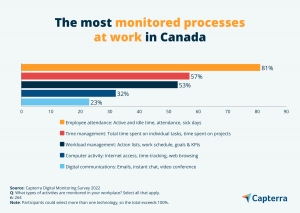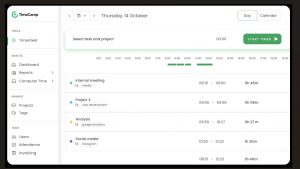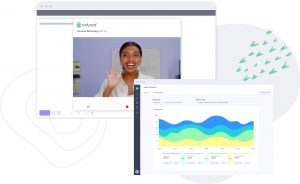More than a third of Canadian employees are being monitored in the workplace. New rules in Ontario say you should be told if you are one of them.
Digital and electronic surveillance tools can track computer, smartphone and other device activity (keystrokes, cursor movement, screen content, data pathways and more); monitor employee communications by phone, email and online chats; and recognize employee faces when coupled with facial recognition software and video camera platforms.

Capterra’s 2022 workplace survey indicated that more than a third of Canadian employees are being monitored in the workplace.
New Ontario legislation regarding workplace surveillance covers any employer with 25 or more employees, and it applies to all employees using company-issued devices — whether they are driving a truck or sending an email.
“[B]businesses have more ways than ever before to monitor where their workers are and what they are doing. Whether you are a delivery person being followed by GPS, a construction worker using a company phone, or an office worker logging in from home, you deserve to know if and how you are being tracked,” said Monte McNaughton, Ontario Minister of Labour, Training and Skills Development, as the amendments were being made.
The new policy won’t change whether your employer is monitoring you or not – employers can and do use various employee surveillance techniques, and for the most part their actions are legal. It’s just that now, they are required to tell you if they track you.
The policy is laid out in the Working for Workers Act, Bill 88, and it includes amendments to the province’s Employment Standards Act. It also makes Ontario the only province in Canada with legislation on employee monitoring.
It says that each year, employers must provide written policy that informs workers whether, how, and in what circumstances their behaviour is monitored by the employer through electronic devices. Employers are not required to report their policies to the government, but they are expected to post their policies for reading and review by March 1.
The legislation does not provide employees with a right to privacy, only a right to transparency from employers regarding the use of electronic data and devices for monitoring purposes.
The policy also starts out with an education-first approach to compliance, meaning there will be no legislated enforcement or penalized non-compliance, at least to start out.
But the legislation does stipulate what an employer’s written electronic monitoring policy with must contain, including a clear statement about whether the employer engages in electronic monitoring of employees. Even if there is no such activity, a policy must be written to say so.
The statement must describe how the employer monitors the employees, such as by using a software program developed to monitor emails and online chats.
The circumstances in which such monitoring takes place, and the end use for any information the employer may gather, must also be described. Often, employee monitoring information is collected and analyzed to evaluate employee performance, to ensure the appropriate use of employer equipment, and to ensure work is being performed during working hours.
Or performed at all.

TimeCamp software can tell the difference between logging on to a non-work site or connecting to a real work-related site or server.
In the recently publicized case of a B.C. worker (therefore not affected by the Ontario legislation), electronic tracking and monitoring uncovered a case of time theft, when an employee said they were working and they were not.
That’s what a civic tribunal found, after reviewing data and performance logs gathered by the employer using a time-tracking software known as TimeCamp.
It records what work files are accessed via computer, and for how long. The records showed a discrepancy between what the employee reported, and was billing for, and what TimeCamp logged as actual work activity.
TimeCamp can also tell the difference – based on computer data pathways – between logging on to a non-work site, like a streaming media platform, or connecting to a real work-related site or server.

Canadian software platform Vidyard has tools to track, measure, and improve the effectiveness of a work team’s video communications.
TimeCamp, a web-based application launched back in 2009, is one of several such tools now widely available. ActiveTrack software says it gives “visibility into employees’ productivity patterns …with accurate efficiency insights”. Clockify, as do other such programs, has a feature whereby screen activity is recorded and made available to system administrators.
The Canadian software platform Vidyard has tools to track, measure, and improve the effectiveness of a work team’s video communications. Even the ubiquitous Office 365 software suite offers ways of tracking how employees spend their time.
As more efficient and effective tools for monitoring computer activity, data exchange and even personal activities are deployed, openly accessible policies and publicly posted procedures are required, for the workplace, the school, the home and the public arena.
-30-



